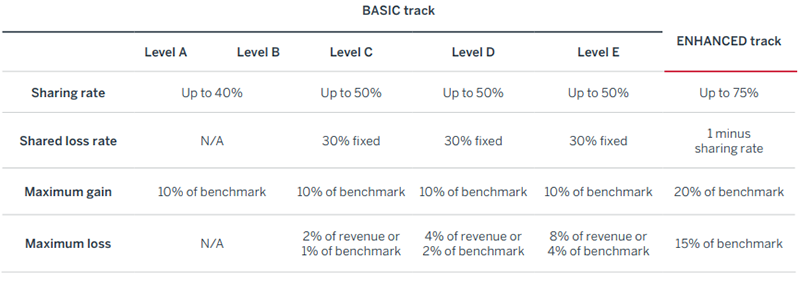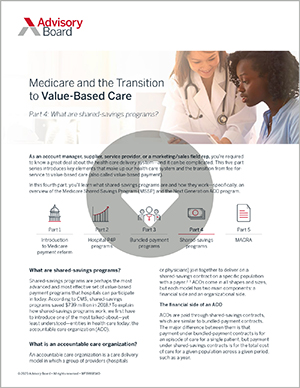Auto logout in seconds.
Continue LogoutShared-savings programs are perhaps the most advanced and most effective set of value-based payment programs that hospitals can participate in today. The Medicare Shared Savings Program (MSSP) is designed to provide high-quality, coordinated care to improve outcomes and reduce costs. Eligible providers, hospitals, and suppliers may participate in shared-savings programs by creating or participating in an Accountable Care Organization (ACO).
As a field sales rep, an account executive, a medical liaison, or a customer service manager in the health care industry, you know that hospitals, health systems, and physician groups across the country continue to evaluate the menu of Medicare ACO options. You can support customers by helping them understand the key details of each model.
In part four of our five-part educational series, you’ll learn what shared-savings programs are and how they work—and get an understanding of the MSSP and the Next Generation ACO program. Check out the below article to get a preview and download part four of our complimentary resource to learn more.
Infographic: How the Medicare ACO Models Stack Up
What are shared-savings programs?
According to CMS, shared-savings programs saved $739 million in 2018. To explain how shared-savings programs work, we first have to introduce one of the most talked-about—yet least understood—entities in health care today: the accountable care organization (ACO).
An accountable care organization is a care delivery model in which a group of providers (hospitals or physicians) join together to deliver on a shared-savings contract on a specific population with a payer. ACOs come in all shapes and sizes, but each model has two main components: a financial side and an organizational side.
The financial side of an ACO
ACOs are paid through shared-savings contracts, which are similar to bundled-payment contracts. The major difference between them is that payment under bundled-payment contracts is for an episode of care for a single patient, but payment under shared-savings contracts is for the total cost of care for a given population across a given period, such as a year.
Another similarity between shared savings and bundled payments is that if the provider spends below the target amount, they can share in a portion of the savings. But if the provider spends above the target, they’re financially responsible for covering the difference.
The organizational side of an ACO
ACOs can be made up of and led by hospitals or physicians—or both. They also can contract with public payers (like Medicare) and private payers (like commercial insurers). For this part of our series, we’ll focus on Medicare ACO programs, which are far more common than commercial ACOs.
What is the Medicare Shared Savings Program?
Introduced in 2012, the Medicare Shared Savings Program (MSSP) is a voluntary program established by the Affordable Care Act. At present, over 7.7 million Medicare beneficiaries are covered by ACOs. MSSP participants have flexibility in how much financial risk they wish to take on as part of the program by choosing among six options that span two tracks.
MSSP offers participants a choice of six options within two tracks

What is MACRA? Learn more.
To learn more about ACOs, how CMS is influencing providers—both hospitals and physicians—to take on financial risk for the patients in their care, the MSSP, and the Next Generation ACO Program, download part four of our complimentary resource, Medicare and the Transition to Value-Based Care.
Don't miss out on the latest Advisory Board insights
Create your free account to access 1 resource, including the latest research and webinars.
Want access without creating an account?
You have 1 free members-only resource remaining this month.
1 free members-only resources remaining
1 free members-only resources remaining
You've reached your limit of free insights
Become a member to access all of Advisory Board's resources, events, and experts
Never miss out on the latest innovative health care content tailored to you.
Benefits include:
You've reached your limit of free insights
Become a member to access all of Advisory Board's resources, events, and experts
Never miss out on the latest innovative health care content tailored to you.
Benefits include:
This content is available through your Curated Research partnership with Advisory Board. Click on ‘view this resource’ to read the full piece
Email ask@advisory.com to learn more
Click on ‘Become a Member’ to learn about the benefits of a Full-Access partnership with Advisory Board
Never miss out on the latest innovative health care content tailored to you.
Benefits Include:
This is for members only. Learn more.
Click on ‘Become a Member’ to learn about the benefits of a Full-Access partnership with Advisory Board
Never miss out on the latest innovative health care content tailored to you.

